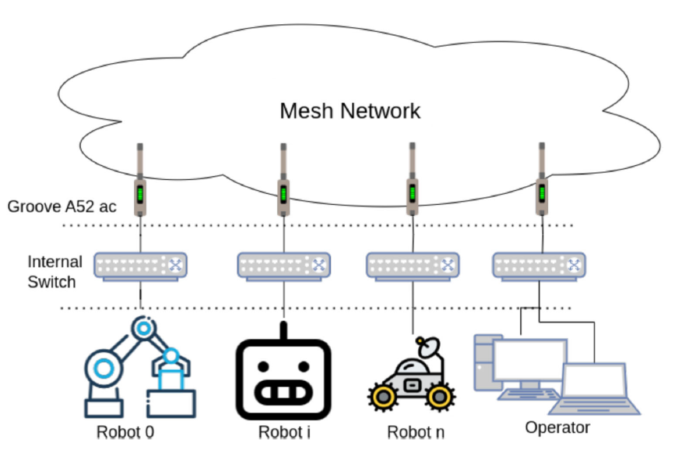By Andy Tomaswick
May 29, 2025
Frameworks are a critical, if underappreciated, component of any space exploration mission. They can range from the overall mission architecture, capturing scientific and technical goals, to the structure of messages sent between two internal components of the system. One of the most interesting frameworks that is getting much attention in the space exploration community is the interaction of multiple robots for a single purpose, known as a multiple-robot system, or MRS. On top of that, one of the most common frameworks for robots on Earth or in space is the open-source Robot Operating System (ROS), which is commonly used to run everything from vacuum cleaners to giant mining trucks. Its most recent iteration, ROS2, even uses yet another framework, known as a middleware, to handle aspects of robot communication such as networking and packetizing data. However, there are plenty of different middlewares to choose from for ROS2, so a team of researchers from the University of Luxembourg decided to try to pick one that would be best for planetary exploration applications.
The appeal of having multiple robots crawling around the moon, exploring while talking to one another, is obvious. However, such a system’s practicality is still far from reality. The most likely candidate for such a solution is a networking system known as a mesh network. A traditional network has a central hub that all the different sub-nodes talk to, which handles the data-intensive processing and interfaces necessary to keep the network operating. On the other hand, a mesh network allows each node to talk to one another without needing a central hub. It has many advantages, such as stability if one of the nodes goes down, and flexibility by finding the fastest way to get data from one node to another. However, it does have the disadvantages of being more computationally intensive for each individual node and laggy compared to the more direct traditional model.
But given the changes in the network that a moving set of robots would experience while exploring extraterrestrial worlds, meshing seems like the best strategy. In a recent paper, the researchers decided to examine three different ROS2 middlewares to see how they would handle a mesh network similar to one they would experience on a lunar mission.
Fraser discusses the use of Robots on the Moon.
The three middlewares were FastDDS, the most common default middleware, CycloneDDS, which specializes in sending large messages, and Zenoh, which specializes in dealing with unstable networks. The DDS in the name of the first two stands for Data Distribution Service, a common protocol for middleware that allows ROS2 to interface with a network “layer”, in the language of engineering models.
Measuring the performance of each middleware would involve calculating five variables: whether or not all robots could be reached, how much overhead the network utilizes, how long it takes for a message to reach an intended target, and the overall utilization of the robot’s CPU and RAM. Each metric captures part of what makes a network usable, especially in deep space.
To test the different frameworks, the authors set up a real-life experiment. Still, instead of exploring the Moon, they set up an MRS to explore the urban environment surrounding their University. Their MRS consisted of a lander, two rovers, and a static antenna. One of the rovers would move away from the other members gradually throughout the experiment, and the network metrics would be continually captured over a range of message sizes.
One part of a mesh network could be a jumping robot, like the kind Fraser discusses in this video.
They found that Zenoh worked best regarding network reliability, data overhead, and delay, though it used slightly more computational power (admittedly from a low base). This platform seems to work well in space exploration environments, though large messages crashing the system, no matter the framework used, was still an issue.
Overall, the experiment described in the paper is a step toward coordinating robots that work in concert on another world. Whether or not the first MRS operating on the Moon or Mars will use Zenoh or another framework, it will only be a matter of time before some networking system, probably a mesh, is in place on another world.
Learn More:
LP Chovet et al – Performance Comparison of ROS2 Middlewares for Multi-robot Mesh Networks in Planetary Exploration
UT – Let the Robot Take the Wheel. Autonomous Navigation in Space
UT – Robots Might Jump Around to Explore the Moon
UT – CADRE’s Three Adorable Rovers Are Going to the Moon


